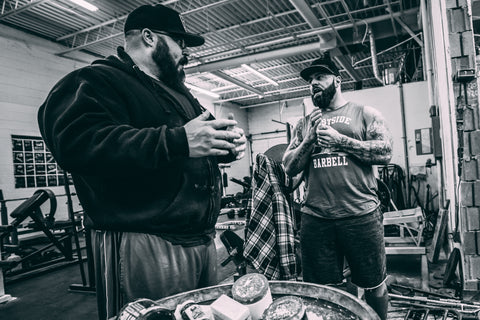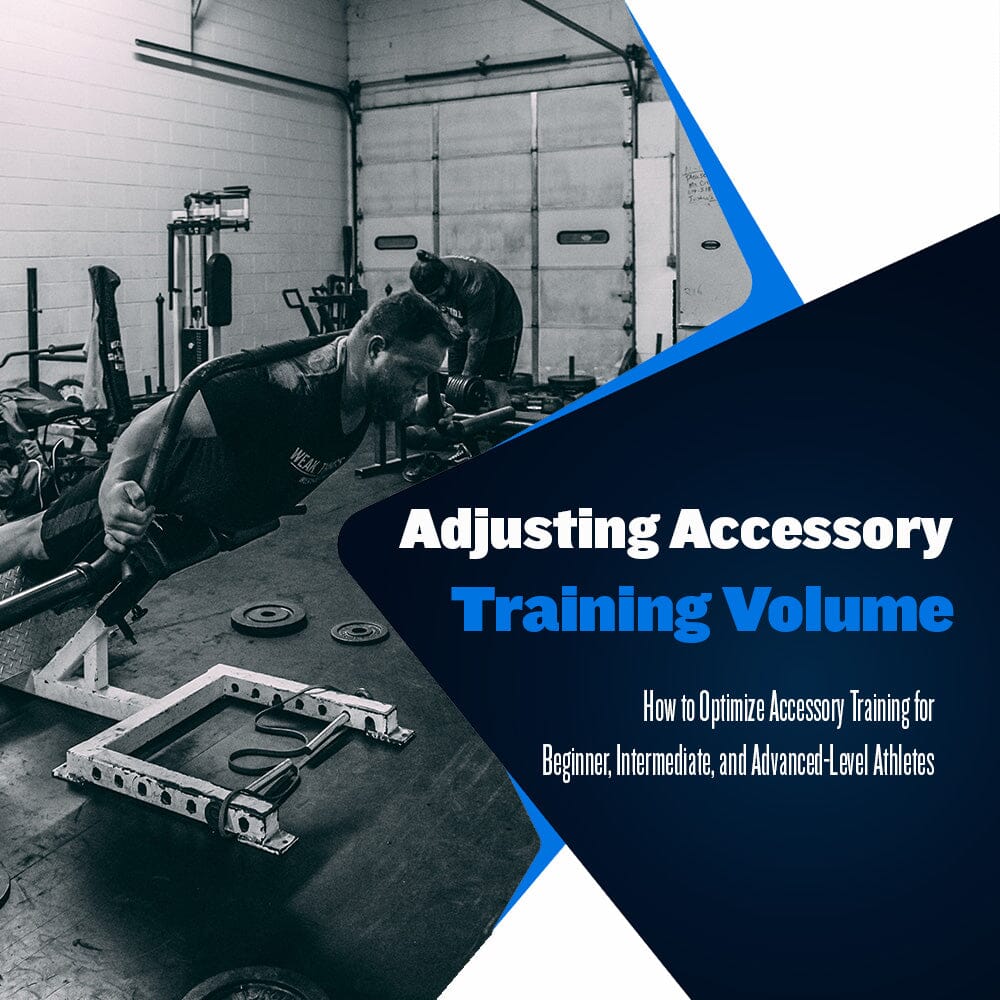Starting Conjugate: Adjusting Accessory Training Volume

Accessory exercise training makes up a considerable amount of our overall weekly training volume. At Westside, we follow a training rule called the 80/20 rule. This rule states that 80% of our training volume will be made up of accessory exercises intended to further improve strength, increase muscle mass, and target weak muscle groups. On each training day, we will select as few as two or as many as five to six accessory exercises to accomplish these training goals.
The set and repetition schemes used during these movements will depend on the intention of the exercise and whether the exercise is a multi or single-joint movement. For instance, a multi-joint movement may be performed at higher intensity levels, with a set and repetition range of 3-5 sets of 5-8 repetitions. At the same time, a single-joint movement will often be programmed for 2-4 sets of 8-10, 12-15, or 15-20 repetitions.
One of the most critical aspects of accessory exercise training is regulating accessory exercise training volume. The Conjugate Method can be utilized by beginner, intermediate, or advanced athletes, provided the training is appropriately regulated. With accessory exercise training, we need to identify the training level of each athlete and ensure the programming is optimized to allow for both improvement and timely recovery.
Below, we will discuss programming strategies to ensure athletes of all levels can successfully utilize the Conjugate Method.
Accessory Training for Beginner-Level Athletes
If an athlete is new to training, ensuring the accessory exercise volume is productive and tolerable is essential. A mistake many beginners make with our training is taking on a high-volume accessory exercise training plan right out of the gate. If an athlete is new to our style of training, our main concern is ensuring they are capable of adequately executing their main exercises during max and dynamic effort training days.
Max and dynamic effort main exercises will be taxing to the beginner athlete. Max effort involves high-intensity training, while dynamic effort training is performed at moderate intensity levels. Both styles of training require specific intent and output from the athlete. Starting with lowered accessory exercise volume in the first month or two is important to ensure workout-to-workout recovery rates remain ideal.
By controlling how we scale up the accessory exercise training volume, we ensure the beginner athlete has the energy and mental focus necessary to master the fundamentals associated with max and dynamic effort main exercises. It would make no sense to immediately force a specific level of accessory training volume onto a beginner athlete only to cause excess fatigue and disrupt the acclimation to the max and dynamic effort main exercise training.
Here is an example of an optimal max-effort training day for a beginner athlete.
Main Exercise:
Squat - work up to a top set single.
Accessory Exercises:
Romanian Deadlift - 3 x 8-10
Reverse Hyper - 3 x 15-20
GHR Sit-Ups - 4 x 15-20
This plan includes three total accessory exercises after the main exercise. The accessory movements selected should be no issue for a beginner to accomplish after performing a max-effort squat.
The first exercise of the day will focus on using basic movements to enhance anterior or posterior lower body strength and muscle mass, while the final two movements help to build the trunk and lower back. The overall training volume for the day should be manageable for the beginner-level athlete, and recovery should be on point to allow for a successful max-effort upper workout during the next training day.
Remember, accessory training volume during dynamic effort days will be lowered considering the training volume associated with dynamic effort main exercises. Here is an example of an optimal dynamic effort training day for a beginner.
Main Exercises:
Box Squat - 5 x 5 @65%
Speed Deadlift - 6 x 2 @65%
Accessory Exercises:
Reverse Hyper - 4 x 15-20
Standing Abs - 4 x 20-30
The accessory volume has been reduced a bit to account for the increase in the main exercise training volume. This allows both main and accessory exercise training to remain effective while allowing the beginner-level athlete to recover appropriately for the next training day.
Accessory Training for Intermediate-Level Athletes
Once a beginner-level athlete has six months to two years utilizing the Conjugate Method, they are typically prepared to escalate their overall training volume. As we mentioned above, the focus for a beginner must be on proper main exercise execution. However, once fundamentals are mastered and recovery rates have become predictable, it is time to increase training volume.
To start, we will add an extra exercise to each workout, along with an extra set or two to each exercise. The additional exercise will give us more options to target specific muscle groups. At the same time, the added sets will increase the training volume on movements already known to improve strength and provide carryover to the main exercises.
Here is an example of an optimal max-effort training day for an intermediate-level athlete.
Main Exercise:
SSB Squat - work up to a top set single.
Accessory Exercises:
Romanian Deadlift - 4 x 8-10
Goblet Squat - 3 x 10-12
Inverse Curl - 3 x AMRAP
Reverse Hyper - 4 x 15-20
GHR Sit-Ups - 4 x 15-20
As you can see, we have added extra exercises with the goblet squat and Inverse Curl while adding an extra set to the Romanian deadlift and Reverse Hyper training. These are simple adjustments that will further challenge the athlete while allowing for an optimal and predictable rate of recovery to be maintained.
Along with our increase in max effort accessory training volume, we will also increase dynamic effort accessory training volume.
Main Exercises:
Box Squat - 5 x 5 @65%
Speed Deadlift - 6 x 2 @65%
Accessory Exercises:
Belt Squat - 4 x 10-12
Reverse Hyper - 4 x 15-20
Standing Abs - 5 x 20-30
Sled Pulls - 10 trips, 20-30 yds per trip.
We have added the belt squat as an extra workout, an extra set to our abdominal training, and an exercise to focus on further development of GPP. These adjustments will help improve strength, muscle mass, and general physical preparation while still allowing the athlete to recover on time for their next workout.
Accessory Training for Advanced-Level Athletes
Reaching the level of an advanced athlete will take some time. Unlike the time it takes to reach the intermediate level (six months to two years), it can take four to ten years to become an advanced-level athlete. Also, depending on age and genetics, it is not guaranteed all athletes will be capable of training at an advanced level.
Accessory exercise training volume for advanced athletes can vary from athlete to athlete. Generally, with advanced-level athletes, we will start with a further increase in accessory exercise training volume while increasing the intensity of accessory exercise training.
Here is an example of an optimal max-effort training day for an advanced-level athlete.
Main Exercise:
SSB Low Box Squat - work up to a top set single.
Accessory Exercises:
Romanian Deadlift - 4 x 5-8
Goblet Squat - 3 x 10-12
Inverse Curl - 4 x AMRAP
Reverse Hyper - 5 x 15-20
GHR Sit-Ups - 4 x 15-20
Backward Sled Pull - 10 trips, 15-20 yds per trip
With the advanced-level athlete, we have increased the intensity of the Romanian deadlifts while also increasing the Inverse Curl and Reverse Hyper training volume. Additionally, we have added GPP training to our max effort training days. This will help to continue improving the physical conditioning of the athlete.
As we increase our max effort accessory training intensity and volume, we will also increase dynamic effort accessory training intensity and volume.
Main Exercises:
Box Squat - 5 x 5 @65%
Speed Deadlift - 8 x 2 @65%
Accessory Exercises:
Belt Squat - 4 x 10-12
Reverse Hyper - 5 x 15-20
KB Swings - 3 x 12-15
Standing Abs - 5 x 20-30
Sled Pulls - 10 trips, 20-30 yds per trip.
Here, we have added two additional sets to our speed deadlifts and an extra set of Reverse Hypers. We have also added kettlebell swings to target the lower back, hips, and glutes while improving conditioning. We could add extra trips to the sled pulls to increase training volume further.
Optimal Volume = Optimal Training
As you begin using the Conjugate Method, it is important to design a training program that meets you at the training level you are at currently. With our methods, an athlete can construct very effective programming no matter their ability level, provided they have some knowledge of the training principles and basic training science associated with our training style.
Too often, athletes overestimate their abilities when beginning to use the Conjugate Method. Understanding that our methods differ from standard linear-based training plans is critical. Our training requires an athlete to train at specific intensity, velocity, and volume levels every week. When transitioning to the Conjugate Method, it is always best to underestimate your abilities and escalate training volume and intensity as needed.
Successful Conjugate Training all comes down to one thing: the ability of the athlete to recover from workout to workout. Maintaining an optimal training volume workout to workout and week to week allows athletes to improve year-round without needing extended deloads or time off from training.
Be honest with yourself, start with an appropriate accessory exercise training volume and intensity, and escalate things as strength and ability improve. Don’t try to keep up with advanced athletes; take your time and train at the most effective level for you personally. The most effective Conjugate training plan is the most optimized plan for the individual executing the training.
Sources:
Simmons, L. (2007). Westside Barbell Book of Methods. Westside Barbell.
Verkhoshansky, Y., & Siff, M. C. (2009). Supertraining. Verkhoshansky.
Zatsiorsky, V. M., & Kraemer, W. J. (2006). Science and Practice of Strength Training. Human Kinetics





